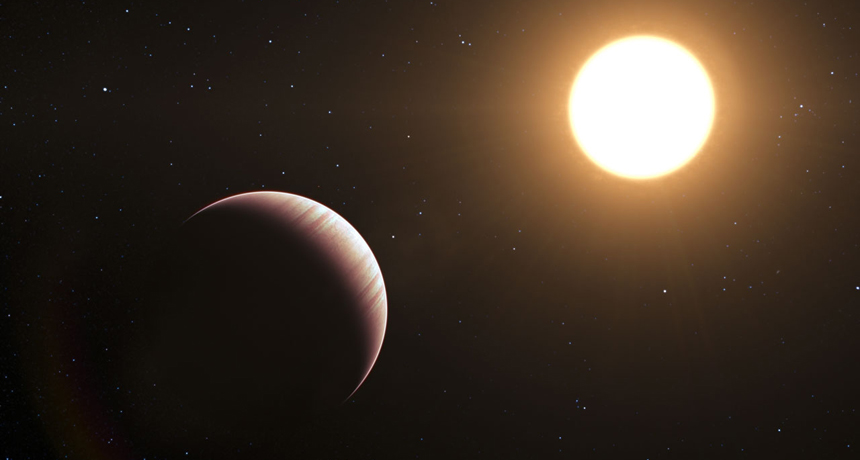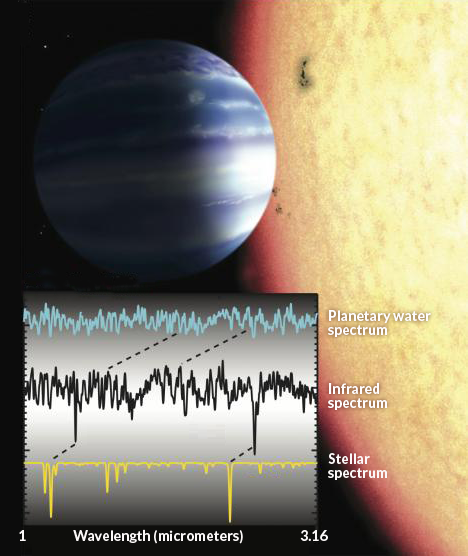Exoplanet water seen in new light
Technique increases number of distant planets with atmospheres that astronomers can study

SUN-SCORCHED WORLD Tau Boötis b orbits close to its sun, as seen in this artist’s illustration. The planet glows brightly with infrared light, which astronomers used to detect water in the planet’s atmosphere.
L. Calçada/ESO
- More than 2 years ago
Exoplanets don’t give up their secrets easily, but astronomers keep finding ways to coax information out of distant worlds. Researchers have used a new technique to detect water vapor around a giant planet 51 light-years from Earth. The method expands the number of exoplanet atmospheres that can be probed.
Exoplanet researchers focus a lot of effort into investigating atmospheres, says Heather Knutson, a Caltech astronomer not involved with the new study. Atmospheres “can tell us interesting things about how planets evolve.” The presence (or absence) of molecules records information about the planet’s environment and formation history. And exoplanet chemistry may be the only sign of life on far-away worlds.
Exoplanet atmospheres are fiendishly difficult to characterize. Measurements of atmospheres around distant planets typically rely on alignments between the planet, its sun and Earth. When the planet crosses in front of, or transits, its star, some of the starlight passes through the planet’s atmosphere. By absorbing certain wavelengths of light, the gases in the atmosphere imprint their signature, allowing astronomers to tease out the chemical makeup of distant planets’ skies.

But because transits are so rare, Knutson says, astronomers miss out on 90 to 99 percent of the planets that are out there.
Alexandra Lockwood, another Caltech astronomer, instead looked for infrared light emanating directly from a planet. Planets are much brighter in infrared light than other wavelengths, making them easier to see against the glare from their suns. Lockwood and her colleagues don’t need the planet to transit the star; they use the planet’s own light to probe its atmosphere.
For this infrared technique to succeed, Lockwood needed a large planet orbiting very close to a bright star. Planets that hug bright stars are very hot — thousands of degrees Celsius — so they emit lots of infrared light. She found an ideal candidate in the planet Tau Boötis b in the constellation Boötis. The gassy planet is six times as massive as Jupiter and whips around its sun once every 3.3 days. Despite the star being 10,000 times brighter than the planet, Lockwood managed to get a peek at the planet’s light by carefully subtracting away the star’s light.
Not only did she see the spectral signature of water, but she also independently confirmed the planet’s mass, demonstrating the validity of her approach. “This gives us the ability to characterize a whole bunch of planets,” she says, “and start to understand the diversity of what’s out there.” She and her colleagues describe their results in the March 10 Astrophysical Journal Letters.
This is not the first time that astronomers have used this infrared method to measure an exoplanet atmosphere. In the last few years, a team at Leiden Observatory in the Netherlands detected carbon monoxide on both Tau Boötis b and HD 209458 b. But this is the first detection of water — a molecule astronomers search for as one of several requirements for habitability.
Knutson, who studies exoplanet atmospheres, is excited about the possibilities. “This gets us around a roadblock we’ve been pounding our head against for the past few years,” she says, adding that Lockwood and colleagues have built a convincing case. “They’ve been very careful in their analysis.”
Astronomers aren’t yet sure how far they can push this technique. With current telescopes, researchers are limited to the hottest planets and brightest stars, which amount to only about a dozen known planets, says Lockwood. But a new generation of larger telescopes, such as the Thirty Meter Telescope and James Webb Space Telescope, is in the works. She hopes many more worlds will reveal their secrets.







